Eritrea Summary
Saturday, 24 March 2018Let’s be honest, Eritrea is not going down as one of my favourite destinations. I’m often surprised by the places from which I depart thinking ‘well that was interesting.’ The Ukraine, Kiev and Chernobyl a couple of years ago. Panama – with the canal, birdwatching, Panama City and the Panama Papers. Even poor sinking-beneath-the-waves Kiribati. In contrast Eritrea was rather disappointing. Asmara for all its wonderful modernist-futurist-rationalist-fascist architecture was too quiet, withdrawn and lacking in any buzz to be really enjoyable. Massawa, the Red Sea port, was simply dead. And Qohaito, the archaeological site? Well I never even got there, due to the incompetence of my rent-a-car company who’d forgotten to put a wheel back on properly.
The real trouble with Eritrea, however, is the same thing that drives refugees out of the country: a lousy government.
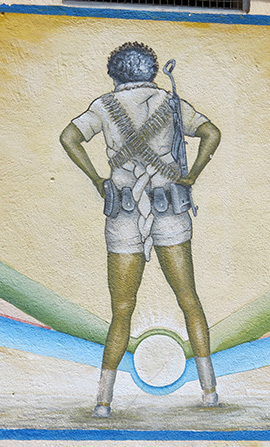
When you have to waste time and money on permits and paperwork and even getting in to the country is a hassle you soon go off the place. I had no trouble getting a visa to Eritrea – thank you to the friendly Eritrean consulate in Melbourne, Australia – but the British traveller I was intending to travel with never got there. The Eritrean embassy in London was still telling him ‘your visa is being processed’ as his flight departed. It’s ridiculous that people are fleeing a country because of its useless economy when at the same time the government is stopping foreign visitors from coming there to spend their money!
◄ The independence struggle with Ethiopia (a country with 25 times the population of little Eritrea) is still a major story for Eritreans, although I never worked out why the revolutionary army was so enthusiastic about short shorts? This wall mural was in Massawa.
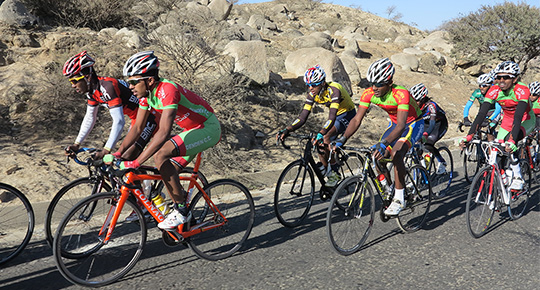 ▲ Ethiopians, Djiboutians, Kenyans – they’re all big names in distance running. Well the equivalent in Eritrea is clearly bicycle racing. In 2015 Daniel Teklehaimanot won a King of the Mountains jersey on a stage at the Tour de France and as a result lycra and flash bikes are a big deal in Eritrea. As I descended towards the coast on a bus from Asmara to Massawa there seemed to a steady stream of cyclist virtually storming uphill towards us. On my way towards Qohaito I encountered this peloton climbing out of Dekemhare.
▲ Ethiopians, Djiboutians, Kenyans – they’re all big names in distance running. Well the equivalent in Eritrea is clearly bicycle racing. In 2015 Daniel Teklehaimanot won a King of the Mountains jersey on a stage at the Tour de France and as a result lycra and flash bikes are a big deal in Eritrea. As I descended towards the coast on a bus from Asmara to Massawa there seemed to a steady stream of cyclist virtually storming uphill towards us. On my way towards Qohaito I encountered this peloton climbing out of Dekemhare.
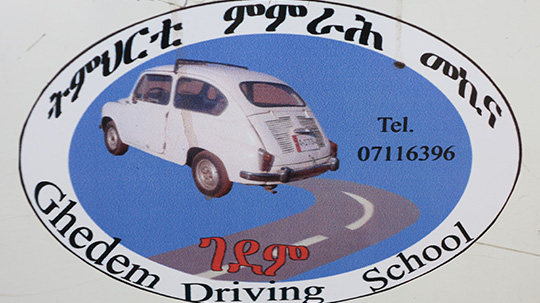 ▲ The Italian influence persists in the capital’s driving schools, all the learner drivers seem to be studying in elderly Fiat 600s, despite all the modern Korean cars in the country.
▲ The Italian influence persists in the capital’s driving schools, all the learner drivers seem to be studying in elderly Fiat 600s, despite all the modern Korean cars in the country.
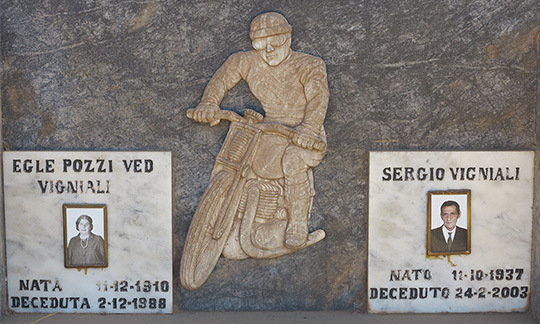 ▲ There are more reminders of the Italian influence in the Italian Cemetery in Asmara. The memorial to Ferruccio Vignali and family noted that although he was an exemplary husband and father he was ‘led to death by his sporting passion’ and the bas relief clearly illustrated what that passion was.
▲ There are more reminders of the Italian influence in the Italian Cemetery in Asmara. The memorial to Ferruccio Vignali and family noted that although he was an exemplary husband and father he was ‘led to death by his sporting passion’ and the bas relief clearly illustrated what that passion was.
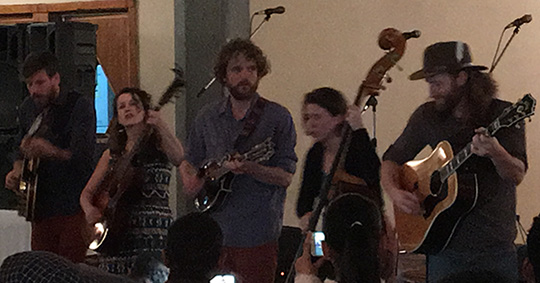 ▲ An Asmara surprise, the US embassy had brought a blue grass band to Eritrea so one night I found myself listening to Crow & the Canyon perform. They concluded an encore with a rather good blue grass version of the Stones’ Dead Flowers.
▲ An Asmara surprise, the US embassy had brought a blue grass band to Eritrea so one night I found myself listening to Crow & the Canyon perform. They concluded an encore with a rather good blue grass version of the Stones’ Dead Flowers.
When I arrived in Asmara the moneychanger at the airport asked me if – since I was from Australia – if I was connected to Bisha. I had no idea what Bisha was, it turns out to be a Canadian mine owned by the company Nevsun with assorted dark clouds hanging over it. A recent article by the Human Rights Law Centre in Australia covers why Eritrea is not a very nice place and Western mining companies – Australian as well as Canadian – should be reconsidering their operations there.






